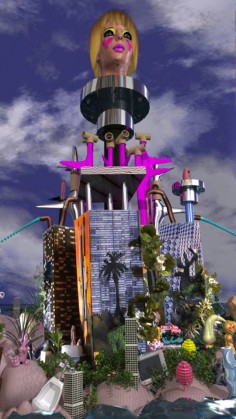KATIE TORN
The Calm Before the Storm
source: katietorn
Single channel 1:38 minute loop
The Calm Before the Storm is a virtual installation assembled of advanced 3D animation and digital video. The viewer experiences the virtual installation through a screen, which becomes a window to a world that mirrors our own, but is distorted in order to express a psychological state of anxiety and excess caused by capitalist culture.
The view through the screen moves around an architectural structure composed of vegetation and garbage; outdated electronics, PVC pipes, toys, and art objects. The structure is an island of capitalist debris, referencing the build up of plastic and chemical waste in the North Pacific and Atlantic oceans. On top of the structure is an idealized american female head that bobs up and down, controlled by mechanics of the architecture. The placement of the head on top of the structure relates the structure and waste beneath to the current state of the human body, as it tries to adapt to the toxic environment that it has created.
.
.
.
.
.
.
.
source: eyebeamorg
Katie Torn is a digital media artist and professor currently living in New York City. Her work employs computer programs used for Hollywood films and commercials to create experimental video works and digital prints that reflect observations on American consumerism, culture, and its impact on the environment and human body. Inspired by Cubism and Futurism, movements that strived to find new ways to express what life was like in an industrial age, Katie uses new technologies to express what life is like in the digital age where interacting in a virtual space is an everyday activity.
Katie studied studio art at The School of the Art Institute of Chicago, graduating with an MFA in 2012.Most recently she performed a live video piece at VIA Music and New Media Festival in Pittsburgh, screened work at SPACE 1026 in Philadelphia, and exhibited work at Platform gallery in New York City. She has a two-person show coming up this fall at Roots and Culture Contemporary Art Center in Chicago.
.
.
.
.
.
.
.
source: anti-utopias
3D computer software is used to create seamless commercials that seduce consumers. Katie Torn’s digital prints and video animations take 3D out of the commercial context and uses it as a means to express psychological states caused by living in a capitalist system.
The work I create is a hybrid of sculpture and photography. The manipulation of forms within the 3D interface is sculptural. I navigate through a Cartesian XYZ space, constructing three-dimensional structures from multiple angles. I then use the virtual camera within the 3D software to create images and videos. The images resemble photographs. Objects cast realistic shadows and have realistic highlights and reflections. However, what the viewer is experiencing are forms that I created in a Hyperreality, where I can control the level of “realness” based on what I want to portray.
I am interested researching the history of virtual reality, its relationship to American consumerism and the prevalence of the hyper-real in our everyday lives. We live in an age where tools for creating a pristine consumer fantasy are rapidly advancing, while our landscape is quickly being cluttered by toxic consumerism made waste. My work integrates the fantasy and the waste together to create worlds that grasp at the gestalt of the American urban experience.
.
.
.
.
.
.
.
.
source: animalnewyork
New York-based artist Katie Torn talks about “The Calm Before the Storm,” a digital animation piece sourced “junk scavenged from both the physical world and the Internet.”
My process usually begins with an image that I can’t get out of my head. I do a lot of sketches, working out different realizations of the image.
I start collecting reference images of things that can help me to conceptualize what I want the piece to be, and make rough collages, sort of like mood boards to help me see it.
For the piece The Calm Before the Storm, I was looking a lot at the French surrealist painter Yves Tanguy. I was drawn to the organic-synthetic quality of the structures in his landscapes. I find his work very contemporary.
The image that I needed to make tangible was an assemblage of the virtual and the physical.
I started by building a real sculpture in my studio, a mix of found objects and painted surfaces.
I captured the structure on video and brought it into the virtual space of Maya so I could continue building up the structure with virtual 3d forms, many of which I found on Google 3D warehouse.


